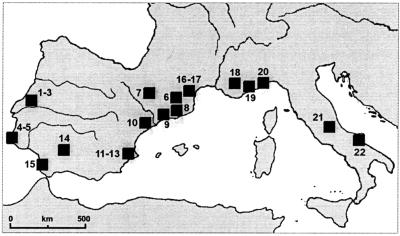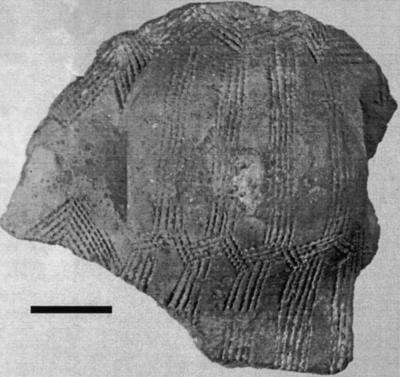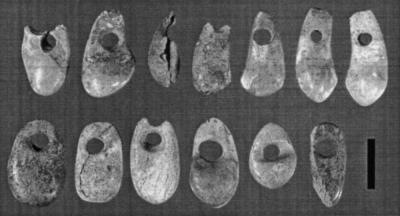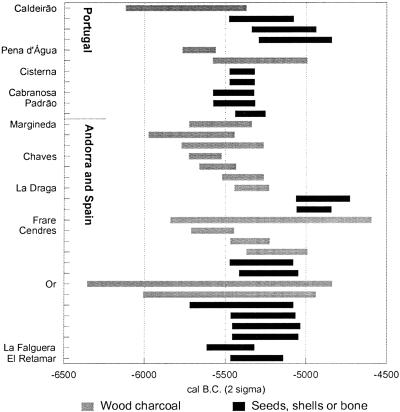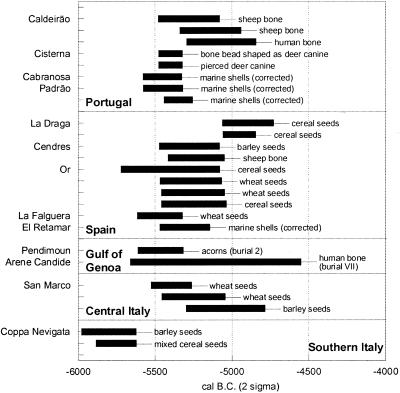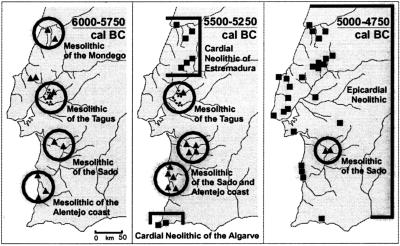Abstract
Most radiocarbon dates for the earliest Neolithic cultures of west Mediterranean Europe are on samples of unidentified charcoal. If only results obtained on short lived samples (seeds, shells, and bone) of diagnostic material (domesticates, artifacts, and human remains) are considered, then the dates for the first appearance of the Neolithic package are indistinguishable statistically from central Italy to Portugal and cluster around 5400 calendar B.C. This rapidity of spread, no more than six generations, can be best explained in the framework of a maritime pioneer colonization model.
Keywords: cardial|Neolithic|radiocarbon
A sound dating of the first appearance of agro-pastoral economies across Europe is a basic prerequisite to the evaluation of how, why, and when hunter-gatherer adaptive systems eventually disappeared from most of the continent in prehistoric times. The task, however, has not proved easy. Before the advent of accelerator mass spectrometer (AMS) radiocarbon dating, bulk samples of charcoal, bone, or shell had to be used, and in many instances the resultant dates were at odds with archaeological expectations based on stratigraphy and typology.
One source of problems was the use of shell samples, providing results biased by reservoir effects. This problem remains largely unsolved except for mid-Holocene marine samples from the western and southern Atlantic seaboards of Iberia. Through the comparison of results obtained by dating different kinds of samples from the same levels (44 shell and 20 charcoal or bone samples from 18 different archaeological contexts), it was possible to establish that the reservoir effect was of 380 ± 30 years for the most common mollusk species accumulated in the shell-middens of the time: Cerastoderma sp., Patella sp., and Mytilus sp. (ref. 1 and Marine Reservoir Correction database, http://radiocarbon.pa.qub.ac.uk/marine/). Thus, Portuguese and western Andalucian late Mesolithic and early Neolithic samples made up of these species can be calibrated now by using the curve for terrestrial samples (2) after subtraction of that apparent age from the raw before present (BP) result.
Another potential source of inaccuracy was the old wood effect, the impact of which was made apparent over the last decade, because the AMS direct dating of diagnostic material (bones from domestic animals and charred cereal seeds) became possible. In the case of the Linear Bandkeramik culture from central Europe, these AMS results suggested that its earliest phase dated to after ≈6400 BP, whereas dates on bulk charcoal samples suggested ages as early as ≈6900 BP (3, 4). AMS dating of domesticates has also shown that the beginning of agriculture in different parts of northwestern Europe was sometimes as much as 2 millennia later than thought previously on the basis of pollen diagrams and the assumption that appearance of “Neolithic” artifacts in the archaeological record could be used as a proxy for the introduction of agro-pastoral economies (5). Similar problems in the New World and Oceania were reported by Fritz (6) and Spriggs (7), respectively. The former noted that AMS dates on remains of the actual domesticated plants from sites in the Tehuacán valley and elsewhere in the Americas suggested the inception of agricultural practices much later than accepted previously on the basis of bulk charcoal samples from the levels containing those remains. The latter showed that “chronometric hygiene” was required for a correct understanding of the Lapita process and, hence, of the human colonization of Polynesia.
In west Mediterranean Europe (Fig. 1), problems inherent to the nature of the samples have been compounded by the fact that most archaeological evidence comes from caves and rock shelters (8). Postdepositional disturbance is commonplace in these kinds of sites; hence, when bulk charcoal samples are used, the association between the dated material and the historical events one wants to date cannot be taken for granted before appropriate critical filters are applied to evaluate the association (9, 10). When scrutinized from a taphonomic perspective, the very early chronology claimed for the inception of production economies in Mediterranean France and Spain must be rejected. The dates (some as early as ≈8000 BP) for the appearance of domesticates in such Spanish sites as Cueva de La Dehesilla (11) and Cova Fosca (12) were obtained from samples collected in disturbed contexts. The dated material contained in variable proportions late Paleolithic, Mesolithic, and Neolithic bone and charcoal, and the Neolithic artifact assemblages found therein corresponded to Epicardial contexts intruded into the underlying late Pleistocene or early Holocene deposits (10).
Figure 1.
Location of sites mentioned in the text. 1–3, Caldeirão, Pena d'Água, and Cisterna; 4–5, Cabranosa and Padrão; 6, Margineda; 7, Chaves; 8, La Draga; 9, Frare; 10, Fosca; 11–13, Cendres, Or, and La Falguera; 14, La Dehesilla; 15, El Retamar; 16–17, Dourgne and Gazel; 18, Baratin; 19, Pendimoun; 20, Arene Candide; 21, San Marco; 22, Coppa Nevigata.
A side issue of the Mesolithic-Neolithic transition as seen from these kinds of sites was the local domestication of goats, suggested for Cova Fosca (13), and the late Mesolithic acquisition of exotic domestic sheep through long distance exchange mechanisms, suggested for Abri Dourgne and Grotte Gazel, among others (14). This was a definitional issue, involving the identification as domesticates of juvenile ovicaprid bones recovered in high mountain sites that might in fact belong to young chamois or ibex. Such identifications created the impression that in these regions the Neolithic did not spread as a complete integrated package. Instead, local hunter-gatherers would have gone through a process of piecemeal independent invention, or adoption, of different elements. However, once the taxonomic status of bones attributed to sheep reported for those Languedoc sites was reevaluated, the evidence for domesticates in the Mesolithic vanished (15). This made it clear that the Cardial and related impressed ware cultures of west Mediterranean Europe represent the simultaneous appearance in the archaeological record of the whole package of features involved in the earliest agro-pastoral practices of the region: animal and plant domesticates, ceramic vessels, polished stone axes, and village dwelling. None of these have ever been found in secure, undisturbed Mesolithic contexts.
Since originally formulated (10), these conclusions have remained unchallenged. Their verification removed any empirical foundation for models describing the emergence of the Neolithic in west Mediterranean Europe as resulting from gradual east-west dispersal of economical and technical innovations. Such models dominated the literature for the last quarter of a century (16–18). They also are difficult to reconcile with the fact that there is no evidence for long distance exchange or trade networks through which indigenous hunter-gatherer groups could have acquired the Neolithic package (or any of its individual components) and transformed themselves into agro-pastoral societies. Moreover, no sound and testable ecological or social explanations have been offered for why local Mesolithic people would have been willing to undertake such a transformation.
These facts suggest that the spread of farming in west Mediterranean Europe was associated with some sort of demic diffusion process such as the “wave of advance” model put forward by Ammerman and Cavalli-Sforza (19, 20). According to their analyses, the annual rate of population growth experienced by frontier farmers can hardly have been greater than 1%, and ethnographically observed rates of migratory activity in similar situations never exceed 2,000 km2 per generation. This rate carries the implication that the model will not work if observed rates for the spread of farming are greater than 2 km/year. Ammerman and Cavalli-Sforza calculated that the average rate from Greece to the British Isles was close to 1 km/year, which is within the model's expectations. Although regional variations in this overall rate were noted, their causes were thought to lie in environmental specificities (as in the Alpine area) or lack of data (as in the eastern Linear Band Keramik area and Iberia), and it was not conceived that their order of magnitude could be such as to threaten the validity of the model.
As more results were obtained, however, it became clear that in some cases (such as the Linear Bandkeramik and Cardial spreads) these regional rates were more than just “somewhat faster” or “somewhat slower” (10, 21). For instance, because the data indicated an inception of the Neolithic ≈5800 calendar (cal) B.C. in Ligúria, ≈5600 cal B.C. in Valencia, and ≈5400 cal B.C. in central Portugal, the rate of spread across the 2,000 km separating the two ends of the geographic distribution of the Cardial had to have been in the range of 5 km/year. Moreover, the style of decoration in ceramics from undated sites in Portugal implies contemporaneity with the earliest Cardial sites of eastern Spain (10, 22) and hence an even faster spread. It was suggested, therefore, that the mechanism best explaining the west Mediterranean process was maritime pioneer colonization (10, 22), a hypothesis first entertained for southern Portugal by Arnaud (23) and for which the occupation of the Pacific islands (24, 25) provides an analogy.
Chronology of the Iberian Cardial
Evidence accumulated over the last few years in Iberia shows that eliminating disturbed sites and mixed levels is not sufficient to obtain an adequate evaluation of the rate of spread of the Cardial. There are problems also with the dating of bulk charcoal or wood samples from levels that are unquestionably in situ because of the old wood effect.
Most frequently, this effect is produced by organic material including charcoal, derived from erosion of the surrounding early Holocene soils that contributed to the formation of deposits accumulated in caves or rock shelters in early Neolithic times. In addition, vertically displaced charcoal from underlying Pleistocene levels may penetrate early Neolithic levels even when no signs of disturbance are visible macroscopically and, hence, go unnoticed during excavation. Finally, the use as timber or as fuel of the centuries-old oak trees that constituted the Mediterranean forest cleared by the first agro-pastoral groups may result in the presence in early Neolithic deposits of wood or charcoal material belonging to the inner rings of those trees, the carbon-14 content of which had begun decaying before they were felled or burned. Ages obtained from samples of such material or including such material may be significantly older than the archaeological events for which dating was sought.
On the basis of evidence from the Portuguese cave site of Caldeirão (9) and the underwater lakeside dwelling of La Draga in northern Catalonia (26), it already had been suggested that this problem affected the dating of the earliest Neolithic in west Mediterranean Europe (10). At Caldeirão, AMS dates on short lived samples of diagnostic Neolithic material (human and sheep bone) indicated an age of ≈5150 cal B.C. for the site's Cardial occupation (Table 1). A conventional date on wood charcoal, however, indicated an age of ≈5750 cal B.C., 600 years earlier. At La Draga, conventional dates on charred cereal seeds indicated an age of ≈4900 cal B.C., as did similar dates on wood charcoal from hearth features, but the wood of an oak pillar was dated to ≈5350 cal B.C., 450 years earlier.
Table 1.
| Site name | Site type | Provenience | Sample | Lab number | Date BP | Cal B.C. 1σ | Cal B.C. 2σ |
|---|---|---|---|---|---|---|---|
| Caldeirão | Cave | Layer Eb | Wood charcoal | ICEN-296 | 6870 ± 210 | 5970–5570 | 6120–5370 |
| Horizon NA2 | Ovis aries bone | OxA-1035 | 6330 ± 80 | 5348–5231 | 5480–5079 | ||
| Horizon NA2 | Ovis aries bone | OxA-1034 | 6230 ± 80 | 5302–5072 | 5340–4940 | ||
| Horizon NA2 | Human bone | OxA-1033 | 6130 ± 90 | 5226–4941 | 5296–4843 | ||
| Pena d'Água | Rock-shelter | Layer Eb (base) | Olea sp. charcoal | Wk-9214 | 6775 ± 60 | 5724–5625 | 5766–5561 |
| Layer Eb (base) | Wood charcoal | ICEN-1146 | 6390 ± 150 | 5467–5215 | 5579–4993 | ||
| Almonda | Cave | Cisterna-AMD2, level 1 | Pierced Cervus elaphus canine | OxA-9287 | 6445 ± 45 | 5473–5369 | 5477–5321 |
| Cisterna-AMD2, level 1 | Bone bead | OxA-9288 | 6445 ± 45 | 5473–5369 | 5477–5321 | ||
| Cabranosa | Open air | Neolithic hearth | Mytilus sp. shells | Sac-1321* | 6930 ± 60 | 5563–5389 | 5579–5325 |
| Padrão | Open air | Hearth | Tapes decussata shells | ICEN-873* | 6920 ± 60 | 5521–5386 | 5577–5318 |
| Hearth | Cerastoderma edule shells | ICEN-645* | 6800 ± 50 | 5432–5278 | 5442–5255 | ||
| Margineda | Cave | Level 3b base | Wood charcoal | Ly-2839 | 6670 ± 120 | 5627–5443 | 5725–5336 |
| Level 3b | Wood charcoal | Ly-3289 | 6850 ± 150 | 5839–5583 | 5977–5443 | ||
| Level 3a | Wood charcoal | Ly-3288 | 6640 ± 160 | 5633–5389 | 5773–5263 | ||
| Chaves | Cave | Level I | Wood charcoal | GRN-12685 | 6770 ± 70 | 5680–5582 | 5726–5523 |
| Level I | Wood charcoal | GRN-12683 | 6650 ± 80 | 5593–5446 | 5662–5433 | ||
| Level I | Wood charcoal | CSIC-378 | 6460 ± 70 | 5440–5312 | 5521–5262 | ||
| Level I | Wood charcoal | GRN-12686 | 5210 ± 340† | Unacceptable, too young | |||
| La Draga | Open air | Hearth E-6 | Wood charcoal | GAK-1523† | 5710 ± 170 | 4772–4357 | 4940–4175 |
| Hearth E-6 | Wood charcoal | UBAR-245† | 5920 ± 240 | 5194–4498 | 5366–4259 | ||
| Hearth E-40 | Wood charcoal | UBAR-311† | 5970 ± 110 | 4960–4718 | 5208–4552 | ||
| Hearth E-50 | Wood charcoal | UBAR-312† | 6570 ± 460 | 5929–5005 | 6360–4466 | ||
| Garbage disposal in H-30 | Animal bone | UBAR-315† | 6700 ± 710 | 6190–4854 | 7042–4046 | ||
| Post E-106 | Quercus wood | UBAR-314 | 6410 ± 70 | 5432–5269 | 5444–5228 | ||
| Hearth E-56 | Cereal seeds | UBAR-313 | 6010 ± 70 | 4951–4806 | 5065–4729 | ||
| Hearth E-3 | Cereal seeds | Hd-15451 | 6060 ± 40 | 5031–4914 | 5061–4845 | ||
| Frare | Cave | T22–23, level 5c | Wood charcoal | I-13030 | 6380 ± 310 | 5579–4946 | 5839–4594 |
| Cendres | Cave | H19 | Single Pinus nigra fleck | Beta-116625† | 20430 ± 170 | Unacceptable, too old | |
| H19a | Single Quercus fleck | Beta-116624† | 8310 ± 80 | Unacceptable, too old | |||
| VIe | Wood charcoal, contaminants included | Ly-4302† | 7540 ± 140 | Unacceptable, too old | |||
| VII | Wood charcoal, contaminants excluded | Beta-75220 | 6730 ± 80 | 5662–5526 | 5712–5446 | ||
| H18 | Wood charcoal, contaminants excluded | Beta-75219 | 6420 ± 80 | 5435–5269 | 5470–5225 | ||
| H17, fireplace | Wood charcoal | Beta-75218 | 6260 ± 80 | 5270–5076 | 5370–4990 | ||
| Estrato VII | Hordeum vulgare | Beta-142228 | 6340 ± 70 | 5457–5262 | 5474–5081 | ||
| VIIa | Ovis aries bone | Beta-107405 | 6280 ± 80 | 5280–5086 | 5416–5049 | ||
| Or | Cave | J4, Levels 16–17 | Wood charcoal | GANOP-C13 | 6720 ± 380 | 5956–5270 | 6356–4837 |
| J4, levels 14–15 | Wood charcoal | GANOP-C12 | 6630 ± 290 | 5733–5270 | 6009–4938 | ||
| Basal Cardial (1955–58) | Cereal seeds | KN-51 | 6510 ± 160 | 5618–5318 | 5722–5079 | ||
| J4, level 17 | Triticum aestivum | OxA-10192 | 6310 ± 70 | 5359–5153 | 5469–5067 | ||
| Upper Cardial (1955–58) | Cereal seeds | H-1754/1208 | 6265 ± 75 | 5316–5079 | 5459–5036 | ||
| J4, level 14 | Triticum aestivum | OxA-10191 | 6275 ± 70 | 5317–5083 | 5459–5048 | ||
| La Falguera | Rock shelter | EU 2051b | Triticum monococcum | Beta-142289 | 6510 ± 70 | 5512–5381 | 5616–5321 |
| El Retamar | Open air | Marine shells | Beta-90122* | 6780 ± 80 | 5434–5259 | 5470–5143 | |
A recently published dating experiment (36) demonstrated conclusively that the old wood effect was indeed a major factor to be considered when accounting for the variability in dates from early Neolithic Iberian sites. The first result to be obtained for the Cardial deposits in Cova de les Cendres (Valencia) is 7540 ± 140 BP. The sample was made up of bulk charcoal, and the result was much earlier than the ≈6700 BP that would have been expected based on the dating of the Cardial elsewhere in Spain and France. This result prompted an investigation of the plant species represented in the charcoal assemblage and the consequent identification of Pinus nigra and Juniperus sp., the most common taxa in the underlying Pleistocene levels. Individual pieces of P. nigra and Quercus sp. found in the Cardial deposits were then submitted to AMS dating, with results of 20430 ± 170 BP for the former and 8310 ± 80 BP for the latter.
These results proved beyond a doubt that pieces of Pleistocene and early Holocene charcoal had made their way into the Cardial deposits. Dating a new series of bulk charcoal samples from which P. nigra and Juniperus sp. were excluded provided results closer to what might have been expected and that were accepted as good by the authors of the experiment: 6730 ± 80 BP and 6420 ± 80 BP. These samples included Quercus sp., however, and given the above-mentioned 8310 ± 80 BP result for an individual fleck of Quercus sp. charcoal from these levels, in all probability these new determinations are skewed also by the old wood effect. This interpretation receives considerable support from the date for another individual fleck of Quercus sp. collected from the uppermost preceramic level of the site: 6670 ± 80 BP (39).
A sample of sheep bone, a short lived diagnostic Neolithic item, was dated to 6280 ± 80 BP. An almost identical result was obtained from charcoal collected in a hearth feature: 6260 ± 80 BP. Both are indistinguishable statistically from a new AMS date of 6340 ± 70 BP for a sample of barley, Hordeum vulgare (39). Together, these three dates show that the 2σ calibrated age of the earliest Neolithic occupation of Cendres lies in the interval between 5000 and 5500 cal B.C.
The major early Neolithic site in Mediterranean Spain undoubtedly is the Cova de l'Or, with its wealth of baroquely decorated ceramic vessels, sophisticated bone tools, personal ornaments, and abundance of cereal and sheep remains (37). These assemblages have been thought to date to ≈5600 cal B.C. on the basis of conventional carbon-14 results on well provenienced bulk charcoal samples from Bernat Martí's 1970s excavations. Despite their large standard deviations, these results might be taken to suggest that the earliest agro-pastoral economies of the region were only slightly later than those of Provence and Ligúria.
Zone AMD2, a burial chamber in the multicomponent Portuguese site of Galeria da Cisterna (Almonda karstic system) excavated in 1988-89 (40), features baroquely decorated Cardial ceramics (Fig. 2), stylistically similar to those from the basal levels of Or, and the same range of ornaments found throughout the latter's early Neolithic sequence. This suggests that the ceramics were deposited in the cave during funerary rituals by the earliest agro-pastoral settlers of littoral-central Portugal and that at least some of the ornaments might belong also to that early Cardial context. In fact, two particular kinds of pendants that are well represented in the Cisterna assemblage, pierced red deer canines and bone beads imitating their shape (Fig. 3), also are absent completely from both the previous Mesolithic and later post-Cardial periods of Portuguese prehistory.
Figure 2.
Baroquely decorated Cardial sherd from Galeria da Cisterna (Vessel 1, zone AMD2). (Scale bar, 2 cm.)
Figure 3.
Pierced red deer canines and bone beads imitating their shape from Galeria da Cisterna, zone AMD2. (Scale bar, 1 cm.)
Because the stylistically early Cardial ceramics from Cisterna were part of a palimpsest accumulated over time in thin Holocene deposits that included later Epicardial, Copper Age, Bronze Age, and Iron Age pottery, no faunal or human bone material could be associated securely with the early Cardial component. Thus, the Cisterna Cardial remained undated until recent publication of the ornaments from Or (41, 42) revealed that the two kinds of pendants mentioned above, pierced red deer canines and bone beads imitating them, are characteristic of the earliest part of that site's Neolithic sequence. This strengthens the hypothesis that such artifacts indeed were associated with the baroquely decorated Cardial pottery from Cisterna and that the Valencian Cardial (as at Or) represents the original cultural background of the first farming societies in littoral-central Portugal. The hypothesis was tested through AMS dating of one specimen of each ornament type, which provided the same result for both samples: 6445 ± 45 BP, that is, ≈5400 cal B.C.
These results are some 200-radiocarbon years younger than current estimates for the age of the lowermost Cardial levels from Or. Because the latter could be skewed by an old wood effect, as suggested by the Cendres experiment, two samples from the same levels, each made up of two charred wheat seeds, were submitted for AMS dating with the following results: 6275 ± 70 BP for level 14 (upper Cardial) and 6310 ± 70 BP for level 17 (basal Cardial). These results are identical statistically to previously available conventional dates on poorly provenienced seed samples from the 1950s excavations. At 2σ, the dates for Cisterna fall within the lower part of the time range represented by the new Or results, which therefore represent a second positive test of the hypothesis of contemporaneity and very close cultural connection between the earliest Neolithic occupations of the two sites.
Cova de l'Or also represents a fourth demonstration, with Caldeirão, La Draga, and Cendres, that the use of bulk charcoal samples blurs what in fact is a very clear picture (Fig. 4). When only results obtained on short lived samples of diagnostic Neolithic items are considered (including those on marine shells collected in Neolithic hearth features excavated at open air sites), all dates for the earliest Cardial, from Valencia to Portugal, are identical statistically. This conclusion receives further support from the new AMS date of 6510 ± 70 BP for wheat seeds from the Cardial levels of the La Falguera rock shelter (39). Such contemporaneity implies a very rapid spread, within a maximum of four or five generations, of the Iberian Cardial.
Figure 4.
2σ calibrated dates for all dated Iberian Cardial sites.
Chronology of the Earliest Neolithic in France and Italy
The Iberian pattern suggests that radiometric chronology for the earliest Neolithic in neighboring regions to the east also may be skewed significantly by the old wood effect. Unfortunately, this hypothesis is difficult to test, because there are very few direct dates on diagnostic material. Those data that are available (refs. 43–46 and BANADORA database, http://carbon14.univ-lyon1.fr/banadora.htm), however, indicate the same problem for those regions.
At the open air site of Baratin (ref. 43 and BANADORA database) in Provence, AMS dates on individual pieces of charcoal from three different features provided ages between 6125 ± 80 BP (Lyon-100/OxA) and 6290 ± 70 BP (Lyon-252/OxA), several centuries younger than the previously available conventional date of 6600 ± 140 BP (Gif-1855). At the Arene Candide cave (44), AMS dating of identified charcoal showed that level 27 yielded both 6150 ± 70 BP (Beta-66552) remains of Phillyrea sp. and 6880 ± 60 BP (Beta-66553) remains of Pistacia terebintus. At Coppa Nevigata (3, 45), two dates on cereal seeds provided virtually identical ages of 6850 ± 80 BP (OxA-1474) and 6880 ± 90 BP (OxA-1475), yet the site was dated previously on conventional bulk charcoal to 7780 ± 320 BP (BM-2557).
The only other site in these regions for which AMS direct dates on diagnostic Neolithic material are available is that of San Marco in Umbria, central Italy (45–46), where three samples of Triticum aestivum, Triticum compactum, and H. vulgare seeds provided results of 6430 ± 80 BP (OxA-1853), 6270 ± 70 BP (OxA-1851), and 6120 ± 90 BP (OxA-1854), respectively. Two other conventional results can be considered also as unmistakably related to the early Neolithic use of the sites in question: the 6490 ± 75 BP (Ly-5340) date on acorns collected inside a burial feature at the Abri Pendimoun (43 and BANADORA database) and the 6255 ± 255 BP (GX-16963G) date on human bone from the burial VII of Arene Candide (44).
When calibrated, these results indicate that the Neolithic begins significantly earlier in southern Italy, perhaps as early as 6000 cal B.C. but that northward and westward all available dates on short lived diagnostic samples are identical to those for Iberia (Fig. 5). The 2σ range for the Cisterna dates (5477–5321 cal B.C.), for instance, falls inside that for the Pendimoun burial (5613–5316 cal B.C.), which is in turn virtually identical to that for La Falguera (5616–5321 cal B.C.). Therefore, the rapidity of spread mentioned above for Iberia applies to the dispersal of the Cardial and related cultures as a whole: 2,000 km from the gulf of Genoa to the estuary of the Mondego in probably no more than 100–200 years at most, that is, at a rate of at least 10–20 km/year. It should be stressed that this conclusion holds even if the French chronology based on conventional bulk charcoal samples is retained, because identical results on the same kinds of samples from in situ Cardial deposits are known in Portugal, not only at Caldeirão but also at Pena d'Água, where a sample of Olea charcoal recently has been dated to 6775 ± 60 BP (28). In any case, these data make it clear that the chronology of the early Neolithic in France and Italy must be revised entirely on the basis of more direct dates of domesticates or on other diagnostic short lived Neolithic materials such as bone artifacts or human bone from burials.
Figure 5.
2σ calibrated dates on short lived diagnostic samples for the earliest Neolithic of west Mediterranean Europe.
Conclusions
By using Ammerman and Cavalli-Sforza's equations (20) and an annual rate of population growth of 1%, one can calculate a rate of spread of 10 km/year, implying a rate of migratory activity of 60,000 km2 per generation, 30 times greater than the maximum observed ethnographically. Demic diffusion therefore cannot have proceeded through a wave of advance mechanism of short distance settlement expansion wherein population growth was accommodated through gradual and slow incorporation of adjacent land.
The area covered by the 40–50-km-wide coastal strip between the Mondego river in Portugal and the cape of Nao, the southern limit of the gulf of Valencia, is precisely 60,000 km2. In the framework of maritime pioneer colonization, the similarities in ornaments and pottery decoration observed between the two extremes of this range can be taken as evidence for a swift expansion with maintenance of cultural traditions, and the littoral placement of settlements is evidence for diffusion through sea routes. In fact, under reasonable estimates of annual population growth, the observed rate of spread across such a large area requires the operation of long distance relocation episodes. It also implies such low population densities across the whole of the settled range that large voids must be postulated between nodes of the farmers' settlement network.
This prediction is met in the archaeological record by the “enclave” nature of early Neolithic territories in littoral-central Portugal, which occupy areas previously uninhabited by late Mesolithic hunter-gatherers. The latter continue to thrive in their own territories for some 500 years after initial Neolithic settlement (refs. 10 and 22; Fig. 6), but contrasts in material culture, economy, nutrition, and mortuary behavior remain unchanged throughout this period. Neolithic sites feature pottery, polished hand axes, and heat pretreatment of flint, which are absent altogether from the Mesolithic, as are domesticates. Neolithic skeletons feature isotopic signatures of a fully terrestrial diet, whereas Mesolithic ones indicate a 50% marine component. Neolithic people are buried in special-purpose collective funerary sites, whereas Mesolithic people are buried individually in habitation sites and have never been found carrying exclusively Neolithic body ornaments (tear-shaped Glycymeris beads, pierced red deer canines, and bone beads imitating them).
Figure 6.
Geographic distribution of late Mesolithic (▴) and early Neolithic (■) settlements in south-central Portugal between 6000 and 4750 cal B.C.
The rapidity of the spread also indicates that long distance colonization events took place well before saturation levels were attained at the point of origin, suggesting that purely historical causes were in operation and that ultimate explanations for the phenomenon must lie within the specific features of antecedent processes triggering the expansion of agro-pastoral economies from their Middle Eastern core areas. One possibility is that after the collapse of the levantine pre-pottery Neolithic B, for which there is significant evidence of social stratification and strongly developed cult practices, the succeeding westward-spreading Neolithic societies, which lack any archaeological evidence of specially built temples and of ranking in settlement or in burial, fissioned before groups became too large and severe conflict or social inequality developed (22, 47, 48). Along the north Mediterranean shores, this tendency to fission and move on would have been reinforced further because opportunities for settlement and expansion around initial enclaves were limited by physical geography and the presence of local hunter-gatherer groups.
Acknowledgments
A. Ammerman, W. K. Barnett, J. Bernabeu, B. Martí, A. Gilman, A. M. Soares, E. Trinkaus, P. J. Watson, and two anonymous reviewers contributed helpful comments on previous versions. The AMS dates for Galeria da Cisterna and Cova de l'Or were funded by the Instituto Português de Arqueologia.
Abbreviations
- AMS
accelerator mass spectrometer
- BP
before present
- Cal
calendar
References
- 1.Monge Soares A. Isotope Techniques in the Study of Past and Current Environmental Changes in the Hydrosphere and the Atmosphere. Vienna: International Atomic Energy Agency; 1993. pp. 471–485. [Google Scholar]
- 2.Stuiver M, Reimer P J, Bard E, Beck J W, Burr G S, Hughen K A, Kromer B, McCormac F G, van der Plicht J, Spurk M. Radiocarbon. 1998;40:1041–1083. [Google Scholar]
- 3.Hedges R E, Housley R A, Law I A, Bronk Ramsey C. Archaeometry. 1989;31:207–234. [Google Scholar]
- 4.Whittle A. Antiquity. 1990;64:297–302. [Google Scholar]
- 5.Rowley-Conwy P. Current Anthropol. 1995;36:346–353. [Google Scholar]
- 6.Fritz G J. Current Anthropol. 1994;35:305–309. [Google Scholar]
- 7.Spriggs M. Antiquity. 1989;63:587–613. [Google Scholar]
- 8.Ammerman A. In: The Widening Harvest. Ammerman A J, Biagi P, editors. Boston: Archaeological Institute of America; 2001. , in press. [Google Scholar]
- 9.Zilhão J. Gruta do Caldeirão. O Neolítico Antigo. Lisboa, Portugal: Instituto Português do Património Arquitectónico e Arqueológico; 1992. [Google Scholar]
- 10.Zilhão J. J Mediterr Archaeol. 1993;6:5–63. [Google Scholar]
- 11.Acosta P, Pellicer M. La cueva de la Dehesilla (Jerez de la Fontera) Jerez, Spain: Consejo Superior de Investigaciones Científicas; 1990. [Google Scholar]
- 12.Olaria C. Cova Fosca. Un asentamiento meso-neolítico de cazadores y pastores en la serranía del Alto Maestrazgo. Castellón, Spain: Servicio de Publicaciones Diputación de Castellón; 1988. [Google Scholar]
- 13.Estévez J. In: Cova Fosca. Un asentamiento meso-neolítico de cazadores y pastores en la serranía del Alto Maestrazgo. Olaria C, editor. Castellón, Spain: Servicio de Publicaciones Diputación de Castellón; 1988. pp. 281–337. [Google Scholar]
- 14.Geddes D. World Archaeol. 1983;15:51–66. [Google Scholar]
- 15.Guilaine J, Barbaza M, Gasco J, Geddes D, Coularou J, Vaquer J, Brochier J-E, Briois F, André J, Jalut G, Vernet J-L. Dourgne. Derniers chasseurs-collecteurs et premiers éleveurs de la Haute-Vallée de l'Aude. Toulouse/Carcassonne, France: Centre d'Anthropologie des Sociétés Rurales/Archéologie en Terre d'Aude; 1993. [Google Scholar]
- 16.Zvelebil M, editor. Hunters in Transition: Mesolithic Societies of Temperate Eurasia and Their Transition to Farming. Cambridge, U.K.: Cambridge Univ. Press; 1986. [Google Scholar]
- 17.Whittle A. Europe in the Neolithic: The creation of New Worlds. Cambridge, U.K.: Cambridge Univ. Press; 1996. [Google Scholar]
- 18.Barnett W K. In: Europe's First Farmers. Price T D, editor. Cambridge, U.K.: Cambridge Univ. Press; 2000. pp. 93–116. [Google Scholar]
- 19.Ammerman A J, Cavalli-Sforza L L. In: The Explanation of Culture Change: Models in Prehistory. Renfrew C, editor. London: Duckworth; 1973. pp. 343–357. [Google Scholar]
- 20.Ammerman A J, Cavalli-Sforza L L. The Neolithic Transition and the Genetics of Population in Europe. Princeton: Princeton Univ. Press; 1984. [Google Scholar]
- 21.Price T D, Gebauer A, Keeley L. In: Last Hunters, First Farmers. Price T D, Gebauer A, editors. Santa Fe, NM: School for American Research Press; 1995. pp. 95–126. [Google Scholar]
- 22.Zilhão J. In: Europe's First Farmers. Price T D, editor. Cambridge, U.K.: Cambridge Univ. Press; 2000. pp. 144–182. [Google Scholar]
- 23.Arnaud J M. Le Néolithique Ancien Méditerranéen. Montpellier, France: Fédération Archéologique de l'Hérault; 1982. pp. 29–48. [Google Scholar]
- 24.Kirch P V. The Evolution of the Polynesian Chiefdoms. Cambridge, U.K.: Cambridge Univ. Press; 1984. [Google Scholar]
- 25.Irwin G. The Prehistoric Exploration and Colonisation of the Pacific. Cambridge, U.K.: Cambridge Univ. Press; 1992. [Google Scholar]
- 26.Tarrús J, Chinchilla J, Bosch A. Bull Soc Préhistorique Fr. 1994;91:449–456. [Google Scholar]
- 27.Zilhão J, Carvalho A M F. Actes. I Congrés del Neolític a la Península Ibérica. Vol. 2. Gavà, Spain: Museu de Gavà; 1996. pp. 659–671. [Google Scholar]
- 28.Carvalho A M F. Abrigo da Pena d'Água. Relatório das escavações de 2000. Lisbon: IPA Archive; 2001. [Google Scholar]
- 29.Cardoso J L, Carreira J R, Ferreira O V. Estudos Arqueológicos de Oeiras. 1996;6:9–26. [Google Scholar]
- 30.Guilaine J, Martzluff M. Les Excavacions a la Balma de la Margineda (1979–1991) Andorra: Govern d'Andorra; 1995. [Google Scholar]
- 31.Martin A. Empúries. 1986–89;48–50:84–102. [Google Scholar]
- 32.Martin A. In: Autour de Jean Arnal. Guilaine J, Gutherz X, editors. Montpellier, France: Université des Sciences et Techniques du Languedoc; 1990. pp. 37–54. [Google Scholar]
- 33.Baldellou V, Castán A. Bolskan. 1983;1:9–37. [Google Scholar]
- 34.Baldellou V, Utrilla P. Trabajos de Prehistoria. 1985;42:83–95. [Google Scholar]
- 35.Bernabeu J. La tradición Cultural de las Cerámicas Impresas en la Zona Oriental de la Península Ibérica. Valencia, Spain: Servicio de Investigación Prehistórica; 1989. [Google Scholar]
- 36.Bernabeu J, Pérez M, Martínez R. Actes del II Congrés del Neolític a la Península Ibèrica. Universitat de València.7–9 d'Abril. 1999. , 1999, eds. Bernabeu, J. & Orozco, T. (Universitat de València, Valencia, Spain), pp. 589–596. [Google Scholar]
- 37.Martí B, Pascual V, Gallart M D, López P, Pérez M, Acuña J D, Robles F. Cova de l'Or (Beniarres, Alicante) Vol. 2. Valencia: Servicio de Investigación Prehistórica; 1980. [Google Scholar]
- 38.Lazarich M, Ramos J, Castañeda V, Pérez M, Herrero N, Lozano J M, García E, Aguilar S, Montañés M, Blanes C. In: II Congreso de Arqueología Peninsular. Tomo I–Paleolítico y Epipaleolítico. Balbín R, Bueno P, editors. Fundación Rei Afonso Henriques: Zamora; 1997. pp. 49–58. [Google Scholar]
- 39.Bernabeu J. Neolithic Landscapes of the Mediterranean: International Symposium. Valencia, Spain: Universitat de València; 2001. , in press. [Google Scholar]
- 40.Zilhão J, Maurício J, Souto P. Actas das IV Jornadas Arqueológicas (Lisboa 1990) (Associação dos Arqueólogos Portugueses, Lisboa, Portugal), pp. 161–171. 1991. [Google Scholar]
- 41.Pascual J L. Recerques del Museu d'Alcoi. 1996;5:17–52. [Google Scholar]
- 42.Pascual J L. Utillaje Óseo, Adornos e Ídolos Neolíticos Valencianos. Valencia, Spain: Servicio de Investigación Prehistórica; 1998. [Google Scholar]
- 43.Binder D. In: Chronologies Néolithiques De 6000 à 2000 Avant Notre Ère dans le Bassin Rhodanien. Voruz J-L, editor. Ambérieu-en-Bagey, France: Société Préhistorique Rhodanienne; 1995. pp. 55–65. [Google Scholar]
- 44.Maggi R. Arene Candide: A Functional and Evironmental Assessment of the Holocene Sequence (excavations Bernabo' Brea-Cardini1940–50) (Istituto Italiano di Paleontologia Umana, Roma, Italy) 1997. [Google Scholar]
- 45.Skeates R. In: The Widening Harvest. Ammerman A J, Biagi P, editors. Boston: Archaeological Institute of America; 2001. , in press. [Google Scholar]
- 46.Hedges R E, Housley R A, Law I A, Bronk Ramsey C. Archaeometry. 1990;32:101–108. [Google Scholar]
- 47.Özdogan M. J Mediterr Archaeol. 1997;5:1–33. [Google Scholar]
- 48.Zilhão J. In: The Widening Harvest. Ammerman A J, Biagi P, editors. Boston: Archaeological Institute of America; 2001. , in press. [Google Scholar]



